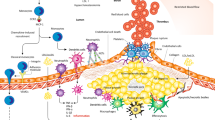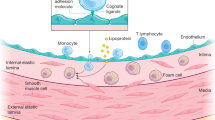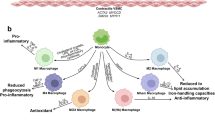Abstract
Atherosclerosis is a chronic disease of the arterial wall, and a leading cause of death and loss of productive life years worldwide. Research into the disease has led to many compelling hypotheses about the pathophysiology of atherosclerotic lesion formation and of complications such as myocardial infarction and stroke. Yet, despite these advances, we still lack definitive evidence to show that processes such as lipoprotein oxidation, inflammation and immunity have a crucial involvement in human atherosclerosis. Experimental atherosclerosis in animals furnishes an important research tool, but extrapolation to humans requires care. Understanding how to combine experimental and clinical science will provide further insight into atherosclerosis and could lead to new clinical applications.
This is a preview of subscription content, access via your institution
Access options
Subscribe to this journal
Receive 51 print issues and online access
$199.00 per year
only $3.90 per issue
Buy this article
- Purchase on SpringerLink
- Instant access to full article PDF
Prices may be subject to local taxes which are calculated during checkout


Similar content being viewed by others
References
Glass, C. K. & Witztum, J. L. Atherosclerosis: the road ahead. Cell 104, 503–516 (2001).
Lusis, A. J. Atherosclerosis. Nature 407, 233–241 (2000).
Libby, P. Vascular biology of atherosclerosis: overview and state of the art. Am. J. Cardiol. 91, 3–6 (2003).
Tabas, I., Williams, K. J. & Boren, J. Subendothelial lipoprotein retention as the initiating process in atherosclerosis: update and therapeutic implications. Circulation 116, 1832–1844 (2007).
Majesky, M. W. Developmental basis of vascular smooth muscle diversity. Arterioscler. Thromb. Vasc. Biol. 27, 1248–1258 (2007).
Gimbrone, M. A. Jr, Topper, J. N., Nagel, T., Anderson, K. R. & Garcia-Cardeña, G. Endothelial dysfunction, hemodynamic forces, and atherogenesis. Ann. NY Acad. Sci. 902, 230–240 (2000).
Swirski, F. K. et al. Ly-6Chi monocytes dominate hypercholesterolemia-associated monocytosis and give rise to macrophages in atheromata. J. Clin. Invest. 117, 195–205 (2007).
Tacke, F. et al. Monocyte subsets differentially employ CCR2, CCR5, and CX3CR1 to accumulate within atherosclerotic plaques. J. Clin. Invest. 117, 185–194 (2007).
Bouhlel, M. A. et al. PPARg activation primes human monocytes into alternative M2 macrophages with anti-inflammatory properties. Cell Metab. 6, 137–143 (2007).
Tabas, I. Macrophage death and defective inflammation resolution in atherosclerosis. Nature Rev. Immunol. 10, 36–46 (2010).
Libby, P. Molecular and cellular mechanisms of the thrombotic complication of atherosclerosis. J. Lipid Res. 50, S352–s357 (2009).
Steinberg, D. The Cholesterol Wars: the Skeptics vs. the Preponderance of Evidence 1st edn (Elsevier, 2007).
Goldstein, J. L. & Brown, M. S. The LDL receptor. Arterioscler. Thromb. Vasc. Biol. 29, 431–438 (2009).
Brown, M. S. & Goldstein, J. L. Heart attacks: gone with the century? Science 272, 629 (1996).
Libby, P. The forgotten majority: unfinished business in cardiovascular risk reduction. J. Am. Coll. Cardiol. 46, 1225–1228 (2005).
Cannon, C. P. et al. Intensive versus moderate lipid lowering with statins after acute coronary syndromes. N. Engl. J. Med. 350, 1495–1504 (2004). This study demonstrates the residual risk for patients who have survived an acute coronary syndrome despite intensive statin treatment.
Nissen, S. E. et al. Effect of very high-intensity statin therapy on regression of coronary atherosclerosis: the ASTEROID trial. J. Am. Med. Assoc. 295, 1556–1565 (2006).
Tall, A. R., Yvan-Charvet, L., Terasaka, N., Pagler, T. & Wang, N. HDL, ABC transporters, and cholesterol efflux: implications for the treatment of atherosclerosis. Cell Metab. 7, 365–375 (2008).
Rye, K. A., Bursill, C. A., Lambert, G., Tabet, F. & Barter, P. J. The metabolism and anti-atherogenic properties of HDL. J. Lipid Res. 50, S195–S200 (2009).
Vaisar, T. et al. Shotgun proteomics implicates protease inhibition and complement activation in the antiinflammatory properties of HDL. J. Clin. Invest. 117, 746–756 (2007).
Brewer, H. B. Jr. High-density lipoproteins: a new potential therapeutic target for the prevention of cardiovascular disease. Arterioscler. Thromb. Vasc. Biol. 24, 387–391 (2004).
Chapman, M. J., Le Goff, W., Guerin, M. & Kontush, A. Cholesteryl ester transfer protein: at the heart of the action of lipid-modulating therapy with statins, fibrates, niacin, and cholesteryl ester transfer protein inhibitors. Eur. Heart J. 31, 149–164 (2010).
Jahangiri, A. et al. HDL remodeling during the acute phase response. Arterioscler. Thromb. Vasc. Biol. 29, 261–267 (2009).
Asztalos, B. F. et al. Differential effects of HDL subpopulations on cellular ABCA1- and SR-BI-mediated cholesterol efflux. J. Lipid Res. 46, 2246–2253 (2005).
Barter, P. J. et al. Effects of torcetrapib in patients at high risk for coronary events. N. Engl. J. Med. 357, 2109–2122 (2007).
Barter, P. J. & Kastelein, J. J. Targeting cholesteryl ester transfer protein for the prevention and management of cardiovascular disease. J. Am. Coll. Cardiol. 47, 492–499 (2006).
Cannon, C. P. et al. Safety of anacetrapib in patients with or at high risk for coronary heart disease. N. Engl. J. Med. 363, 2406–2415 (2010).
Nissen, S. E. et al. Effect of recombinant ApoA-I Milano on coronary atherosclerosis in patients with acute coronary syndromes: a randomized controlled trial. J. Am. Med. Assoc. 290, 2292–2300 (2003).
Tardif, J. C. et al. Effects of reconstituted high-density lipoprotein infusions on coronary atherosclerosis: a randomized controlled trial. J. Am. Med. Assoc. 297, 1675–1682 (2007).
Navab, M. et al. Human apolipoprotein AI mimetic peptides for the treatment of atherosclerosis. Curr. Opin. Investig. Drugs 4, 1100–1104 (2003).
Staels, B. Fibrates in CVD: a step towards personalised medicine. Lancet 375, 1847–1848 (2010).
Frick, M. H. et al. Helsinki Heart Study: primary-prevention trial with gemfibrozil in middle-aged men with dyslipidemia. N. Engl. J. Med. 317, 1237–1245 (1987).
Robins, S. J. et al. Relation of gemfibrozil treatment and lipid levels with major coronary events. VA-HIT: a randomized controlled trial. J. Am. Med. Assoc. 285, 1585–1591 (2001).
Jones, P. H. & Davidson, M. H. Reporting rate of rhabdomyolysis with fenofibrate + statin versus gemfibrozil + any statin. Am. J. Cardiol. 95, 120–122 (2005).
Keech, A. et al. Effects of long-term fenofibrate therapy on cardiovascular events in 9795 people with type 2 diabetes mellitus (the FIELD study): randomised controlled trial. Lancet 366, 1849–1861 (2005).
Ginsberg, H. N. et al. Effects of combination lipid therapy in type 2 diabetes mellitus. N. Engl. J. Med. 362, 1563–1574 (2010).
Taggart, A. K. et al. (D)-β-Hydroxybutyrate inhibits adipocyte lipolysis via the nicotinic acid receptor PUMA-G. J. Biol. Chem. 280, 26649–26652 (2005). This paper identifies a target of nicotinic acid action that may provide mechanistic insight into its mode of action.
Brown, B. G. & Zhao, X. Q. Nicotinic acid, alone and in combinations, for reduction of cardiovascular risk. Am. J. Cardiol. 101, 58B–62B (2008).
Duffy, D. & Rader, D. J. Update on strategies to increase HDL quantity and function. Nature Rev. Cardiol. 6, 455–463 (2009).
Sarwar, N. et al. Triglycerides and the risk of coronary heart disease: 10,158 incident cases among 262,525 participants in 29 Western prospective studies. Circulation 115, 450–458 (2007).
Gerstein, H. C. et al. Effects of intensive glucose lowering in type 2 diabetes. N. Engl. J. Med. 358, 2545–2559 (2008).
Duckworth, W. et al. Glucose control and vascular complications in veterans with type 2 diabetes. N. Engl. J. Med. 360, 129–139 (2009).
Jun, M. et al. Effects of fibrates on cardiovascular outcomes: a systematic review and meta-analysis. Lancet 375, 1875–1884 (2010).
Siscovick, D. S., Lemaitre, R. N. & Mozaffarian, D. The fish story: a diet–heart hypothesis with clinical implications: n-3 polyunsaturated fatty acids, myocardial vulnerability, and sudden death. Circulation 107, 2632–2634 (2003).
Kawakami, A. et al. Toll-like receptor 2 mediates apolipoprotein CIII-induced monocyte activation. Circ. Res. 103, 1402–1409 (2008).
Mullick, A. E., Tobias, P. S. & Curtiss, L. K. Modulation of atherosclerosis in mice by Toll-like receptor 2. J. Clin. Invest. 115, 3149–3156 (2005).
Eriksson, P., Nilsson, L., Karpe, F. & Hamsten, A. Very-low-density lipoprotein response element in the promoter region of the human plasminogen activator inhibitor-1 gene implicated in the impaired fibrinolysis of hypertriglyceridemia. Arterioscler. Thromb. Vasc. Biol. 18, 20–26 (1998).
Berliner, J. A. & Watson, A. D. A role for oxidized phospholipids in atherosclerosis. N. Engl. J. Med. 353, 9–11 (2005).
Steinberg, D. The LDL modification hypothesis of atherogenesis: an update. J. Lipid. Res. 50, S376–S381 (2009). A balanced weighing of the oxidized-lipid hypothesis of atherosclerosis from a pioneer in the field.
Steinberg, D. & Witztum, J. L. Oxidized low-density lipoprotein and atherosclerosis. Arterioscler. Thromb. Vasc. Biol. 30, 2311–2316 (2010).
Lonn, E. et al. Effects of long-term vitamin E supplementation on cardiovascular events and cancer: a randomized controlled trial. J. Am. Med. Assoc. 293, 1338–1347 (2005).
Lonn, E. et al. Homocysteine lowering with folic acid and B vitamins in vascular disease. N. Engl. J. Med. 354, 1567–1577 (2006).
Steinberg, D. & Witztum, J. L. Is the oxidative modification hypothesis relevant to human atherosclerosis? Circulation 105, 2107–2111 (2002).
Tardif, J. C. et al. Effects of succinobucol (AGI-1067) after an acute coronary syndrome: a randomised, double-blind, placebo-controlled trial. Lancet 371, 1761–1768 (2008).
Serruys, P. W. et al. Effects of the direct lipoprotein-associated phospholipase A2 inhibitor darapladib on human coronary atherosclerotic plaque. Circulation 118, 1172–1182 (2008).
Jonasson, L., Holm, J., Skalli, O., Bondjers, G. & Hansson, G. K. Regional accumulations of T cells, macrophages, and smooth muscle cells in the human atherosclerotic plaque. Arteriosclerosis 6, 131–138 (1986).
Hansson, G. K. & Libby, P. The immune response in atherosclerosis: a double-edged sword. Nature Rev. Immunol. 6, 508–519 (2006).
Hartvigsen, K. et al. The role of innate immunity in atherogenesis. J. Lipid. Res. 50, S388–393 (2008).
Andersson, J., Libby, P. & Hansson, G. K. Adaptive immunity and atherosclerosis. Clin. Immunol. 134, 33–46 (2010).
Palinski, W., Miller, E. & Witztum, J. L. Immunization of low density lipoprotein (LDL) receptor-deficient rabbits with homologous malondialdehyde-modified LDL reduces atherogenesis. Proc. Natl Acad. Sci. USA 92, 821–825 (1995).
Maron, R. et al. Mucosal administration of heat shock protein-65 decreases atherosclerosis and inflammation in aortic arch of low-density lipoprotein receptor-deficient mice. Circulation 106, 1708–1715 (2002).
Hansson, G. K. & Nilsson, J. Vaccination against atherosclerosis? Induction of atheroprotective immunity. Semin. Immunopathol. 31, 95–101 (2009).
Hermansson, A. et al. Inhibition of T cell response to native low-density lipoprotein reduces atherosclerosis. J. Exp. Med. 207, 1081–1093 (2010).
Robertson, A. K. et al. Disruption of TGF-β signaling in T cells accelerates atherosclerosis. J. Clin. Invest. 112, 1342–1350 (2003).
Ait-Oufella, H. et al. Natural regulatory T cells control the development of atherosclerosis in mice. Nature Med. 12, 178–180 (2006).
van Es, T. et al. Attenuated atherosclerosis upon IL-17R signaling disruption in LDLr deficient mice. Biochem. Biophys. Res. Commun. 388, 261–265 (2009).
Taleb, S., Tedgui, A. & Mallat, Z. Interleukin-17: friend or foe in atherosclerosis? Curr. Opin. Lipidol. 21, 404–408 (2010).
Taleb, S. et al. Loss of SOCS3 expression in T cells reveals a regulatory role for interleukin-17 in atherosclerosis. J. Exp. Med. 206, 2067–2077 (2009).
Madhur, M. S. et al. Role of interleukin 17 in inflammation, atherosclerosis, and vascular function in apolipoprotein E-deficient mice. Arterioscler. Thromb. Vasc. Biol. doi:10.1161/ATVBAHA.111.227629 2011 (7 April 2011).
Cheng, X. et al. Inhibition of IL-17A in atherosclerosis. Atherosclerosis 215, 471–474 (2011).
Caligiuri, G., Nicoletti, A., Poirier, B. & Hansson, G. K. Protective immunity against atherosclerosis carried by B cells of hypercholesterolemic mice. J. Clin. Invest. 109, 745–753 (2002).
Ait-Oufella, H. et al. B cell depletion reduces the development of atherosclerosis in mice. J. Exp. Med. 207, 1579–1587 (2010).
Bentzon, J. F. & Falk, E. Atherosclerotic lesions in mouse and man: is it the same disease? Curr. Opin. Lipidol. 21, 434–440 (2010).
Nussenblatt, R. B. et al. National Institutes of Health Center for Human Immunology Conference, September 2009. Ann. NY Acad. Sci. 1200, E1–E23 (2010). A recent compilation of some of the distinctions between the human and mouse immune systems.
Tran, D. Q., Ramsey, H. & Shevach, E. M. Induction of FOXP3 expression in naive human CD4+FOXP3− T cells by T-cell receptor stimulation is transforming growth factor-β-dependent but does not confer a regulatory phenotype. Blood 110, 2983–2990 (2007).
Raes, G., Van den Bergh, R., De Baetselier, P. & Ghassabeh, G. H. Arginase-1 and Ym1 are markers for murine, but not human, alternatively activated myeloid cells. J. Immunol. 174, 6561–6562 (2005).
Hansson, G. K. Inflammation, atherosclerosis, and coronary artery disease. N. Engl. J. Med. 352, 1685–1695 (2005).
Libby, P. & Ridker, P. M. Inflammation and atherothrombosis. J. Am. Coll. Cardiol. 48, 33–46 (2006).
Grosser, T., Fries, S. & FitzGerald, G. A. Biological basis for the cardiovascular consequences of COX-2 inhibition: therapeutic challenges and opportunities. J. Clin. Invest. 116, 4–15 (2006).
Ridker, P. M. et al. C-reactive protein levels and outcomes after statin therapy. N. Engl. J. Med. 352, 20–28 (2005).
Ridker, P. M. et al. Reduction in C-reactive protein and LDL cholesterol and cardiovascular event rates after initiation of rosuvastatin: a prospective study of the JUPITER trial. Lancet 373, 1175–1182 (2009).
Harismendy, O. et al. 9p21 DNA variants associated with coronary artery disease impair interferon-γ signalling response. Nature 470, 264–268 (2011).
Schunkert, H. et al. Repeated replication and a prospective meta-analysis of the association between chromosome 9p21.3 and coronary artery disease. Circulation 117, 1675–1684 (2008).
Kathiresan, S. et al. Six new loci associated with blood low-density lipoprotein cholesterol, high-density lipoprotein cholesterol or triglycerides in humans. Nature Genet. 40, 189–197 (2008).
Morgan, T. M., Krumholz, H. M., Lifton, R. P. & Spertus, J. A. Nonvalidation of reported genetic risk factors for acute coronary syndrome in a large-scale replication study. J. Am. Med. Assoc. 297, 1551–1561 (2007). This paper describes the lack of reproducibility of associations between single-nucleotide polymorphisms and atherosclerotic outcomes.
Paynter, N. P. et al. Association between a literature-based genetic risk score and cardiovascular events in women. J. Am. Med. Assoc. 303, 631–637 (2010). This study shows that a panel of reproducible genetic variants from genome-wide association studies does not improve cardiovascular risk prediction.
Ridker, P. M. et al. Rosuvastatin to prevent vascular events in men and women with elevated C-reactive protein. N. Engl. J. Med. 359, 2195–2207 (2008).
Libby, P., Di Carli, M. F. & Weissleder, R. The vascular biology of atherosclerosis and imaging targets. J. Nucl. Med. 51 (suppl. 1), 33S–37S (2010).
Altmann, S. W. et al. Niemann-Pick C1 like 1 protein is critical for intestinal cholesterol absorption. Science 303, 1201–1204 (2004).
Cohen, J. C., Boerwinkle, E., Mosley, T. H. Jr & Hobbs, H. H. Sequence variations in PCSK9, low LDL, and protection against coronary heart disease. N. Engl. J. Med. 354, 1264–1272 (2006). This study identifies a new target for LDL lowering and provides evidence that life-long low LDL levels confer considerable cardiovascular protection, reinforcing and extending the results of short-term drug-intervention trials.
Brown, M. S. & Goldstein, J. L. Lowering LDL — not only how low, but how long? Science 311, 1721–1723 (2006).
Wang, C. Y., Liu, P. Y. & Liao, J. K. Pleiotropic effects of statin therapy: molecular mechanisms and clinical results. Trends Mol. Med. 14, 37–44 (2008).
Parmar, K. M. et al. Integration of flow-dependent endothelial phenotypes by Kruppel-like factor 2. J. Clin. Invest. 116, 49–58 (2006).
Ridker, P. M. Testing the inflammatory hypothesis of atherothrombosis: scientific rationale for the cardiovascular inflammation reduction trial (CIRT). J. Thromb. Haemost. 7 (suppl. s1), 332–339 (2009).
Duewell, P. et al. NLRP3 inflammasomes are required for atherogenesis and activated by cholesterol crystals. Nature 464, 1357–1361 (2010).
Rajamaki, K. et al. Cholesterol crystals activate the NLRP3 inflammasome in human macrophages: a novel link between cholesterol metabolism and inflammation. PLoS ONE 5, e11765 (2010).
Acknowledgements
We thank S. Karwacki for editorial assistance.
Author information
Authors and Affiliations
Corresponding author
Ethics declarations
Competing interests
P.M.R. is a co-inventor on patents held by Brigham and Women's Hospital relating to the use of inflammatory biomarkers in the diagnosis and treatment of cardiovascular disease, that have been licensed to Siemens and AstraZeneca. G.K.H. is a co-inventor on patents relating to immunotherapy against atherosclerotic cardiovascular disease.
Additional information
Reprints and permissions information is available at http://www.nature.com/reprints.
Rights and permissions
About this article
Cite this article
Libby, P., Ridker, P. & Hansson, G. Progress and challenges in translating the biology of atherosclerosis. Nature 473, 317–325 (2011). https://doi.org/10.1038/nature10146
Published:
Issue Date:
DOI: https://doi.org/10.1038/nature10146
This article is cited by
-
Prevalence and trend of multiple coronary artery disease risk factors and their 5-year incidence rate among adult population of Kerman: results from KERCADR study
BMC Public Health (2024)
-
Contrasting the relationship of serum uric acid/albumin ratio on quantitative flow ratio with other multiple composite parameters in patients with suspected coronary artery disease
BMC Cardiovascular Disorders (2024)
-
Characterization of the proteome of stable and unstable carotid atherosclerotic plaques using data-independent acquisition mass spectrometry
Journal of Translational Medicine (2024)
-
MiR-181a protects the heart against myocardial infarction by regulating mitochondrial fission via targeting programmed cell death protein 4
Scientific Reports (2024)
-
Cardiovascular events risk in patients with systemic autoimmune diseases: a prognostic systematic review and meta-analysis
Clinical Research in Cardiology (2024)



